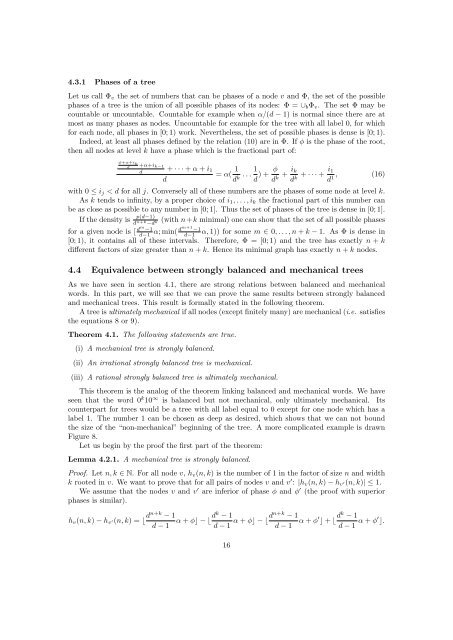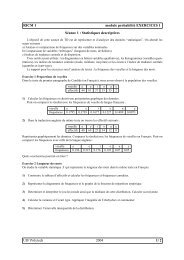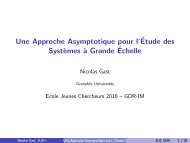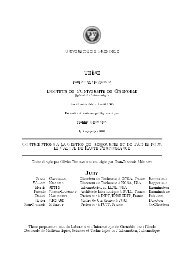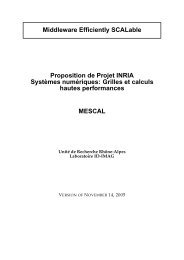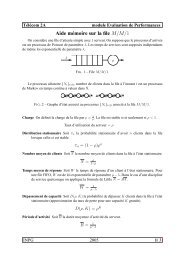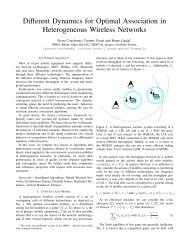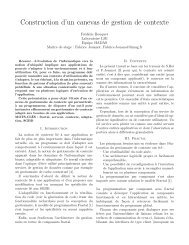Distributing labels on infinite trees
Distributing labels on infinite trees
Distributing labels on infinite trees
You also want an ePaper? Increase the reach of your titles
YUMPU automatically turns print PDFs into web optimized ePapers that Google loves.
4.3.1 Phases of a treeLet us call Φ v the set of numbers that can be phases of a node v and Φ, the set of the possiblephases of a tree is the uni<strong>on</strong> of all possible phases of its nodes: Φ = ∪ b Φ v . The set Φ may becountable or uncountable. Countable for example when α/(d − 1) is normal since there are atmost as many phases as nodes. Uncountable for example for the tree with all label 0, for whichfor each node, all phases in [0; 1) work. Nevertheless, the set of possible phases is dense is [0; 1).Indeed, at least all phases defined by the relati<strong>on</strong> (10) are in Φ. If φ is the phase of the root,then all nodes at level k have a phase which is the fracti<strong>on</strong>al part of:φ+α+i kd +α+i k−1d+ · · · + α + i 1= α( 1 dd k . . . 1 d ) + φ d k + i kd k + · · · + i 1d 1 , (16)with 0 ≤ i j < d for all j. C<strong>on</strong>versely all of these numbers are the phases of some node at level k.As k tends to infinity, by a proper choice of i 1 , . . . , i k the fracti<strong>on</strong>al part of this number canbe as close as possible to any number in [0; 1]. Thus the set of phases of the tree is dense in [0; 1].If the density isp(d−1)d n+k −d k(with n+k minimal) <strong>on</strong>e can show that the set of all possible phasesfor a given node is [ dm −1d−1 α; min( dm+1 −1d−1α, 1)) for some m ∈ 0, . . . , n + k − 1. As Φ is dense in[0; 1), it c<strong>on</strong>tains all of these intervals. Therefore, Φ = [0; 1) and the tree has exactly n + kdifferent factors of size greater than n + k. Hence its minimal graph has exactly n + k nodes.4.4 Equivalence between str<strong>on</strong>gly balanced and mechanical <strong>trees</strong>As we have seen in secti<strong>on</strong> 4.1, there are str<strong>on</strong>g relati<strong>on</strong>s between balanced and mechanicalwords. In this part, we will see that we can prove the same results between str<strong>on</strong>gly balancedand mechanical <strong>trees</strong>. This result is formally stated in the following theorem.A tree is ultimately mechanical if all nodes (except finitely many) are mechanical (i.e. satisfiesthe equati<strong>on</strong>s 8 or 9).Theorem 4.1. The following statements are true.(i) A mechanical tree is str<strong>on</strong>gly balanced.(ii) An irrati<strong>on</strong>al str<strong>on</strong>gly balanced tree is mechanical.(iii) A rati<strong>on</strong>al str<strong>on</strong>gly balanced tree is ultimately mechanical.This theorem is the analog of the theorem linking balanced and mechanical words. We haveseen that the word 0 k 10 ∞ is balanced but not mechanical, <strong>on</strong>ly ultimately mechanical. Itscounterpart for <strong>trees</strong> would be a tree with all label equal to 0 except for <strong>on</strong>e node which has alabel 1. The number 1 can be chosen as deep as desired, which shows that we can not boundthe size of the “n<strong>on</strong>-mechanical” beginning of the tree. A more complicated example is drawnFigure 8.Let us begin by the proof the first part of the theorem:Lemma 4.2.1. A mechanical tree is str<strong>on</strong>gly balanced.Proof. Let n, k ∈ N. For all node v, h v (n, k) is the number of 1 in the factor of size n and widthk rooted in v. We want to prove that for all pairs of nodes v and v ′ : |h v (n, k) − h v ′(n, k)| ≤ 1.We assume that the nodes v and v ′ are inferior of phase φ and φ ′ (the proof with superiorphases is similar).h v (n, k) − h v ′(n, k) = ⌊ dn+k − 1d − 1 α + φ⌋ − ⌊dk − 1d − 1 α + φ⌋ − ⌊dn+k − 1d − 1 α + φ′ ⌋ + ⌊ dk − 1d − 1 α + φ′ ⌋.16


